Quick Summary:
Ruby on rails vs Django are both the best web development frameworks. Back-end systems are like the backbones of the digital product. When you are building one, you must pay utmost attention to the backend side of things. You don’t want to go wrong on this. This post discusses the two most popular choices for backend development — Django vs ruby on rails
Many developers compare Ruby on Rails vs Django to determine which web framework is the best for their web app. This is because out of all the web development frameworks available. Choosing the right technology for your web application development project is not always easy. In many cases, the technology you choose will depend largely on the skills your developer posses.
Django Vs Rails Popularity
According to SimilarTech, There are approx 437,855 live websites using Ruby on Rails. Its also very widely used across industries. whereas about 90,853 live websites are using Django. Its also very widely used across industries.
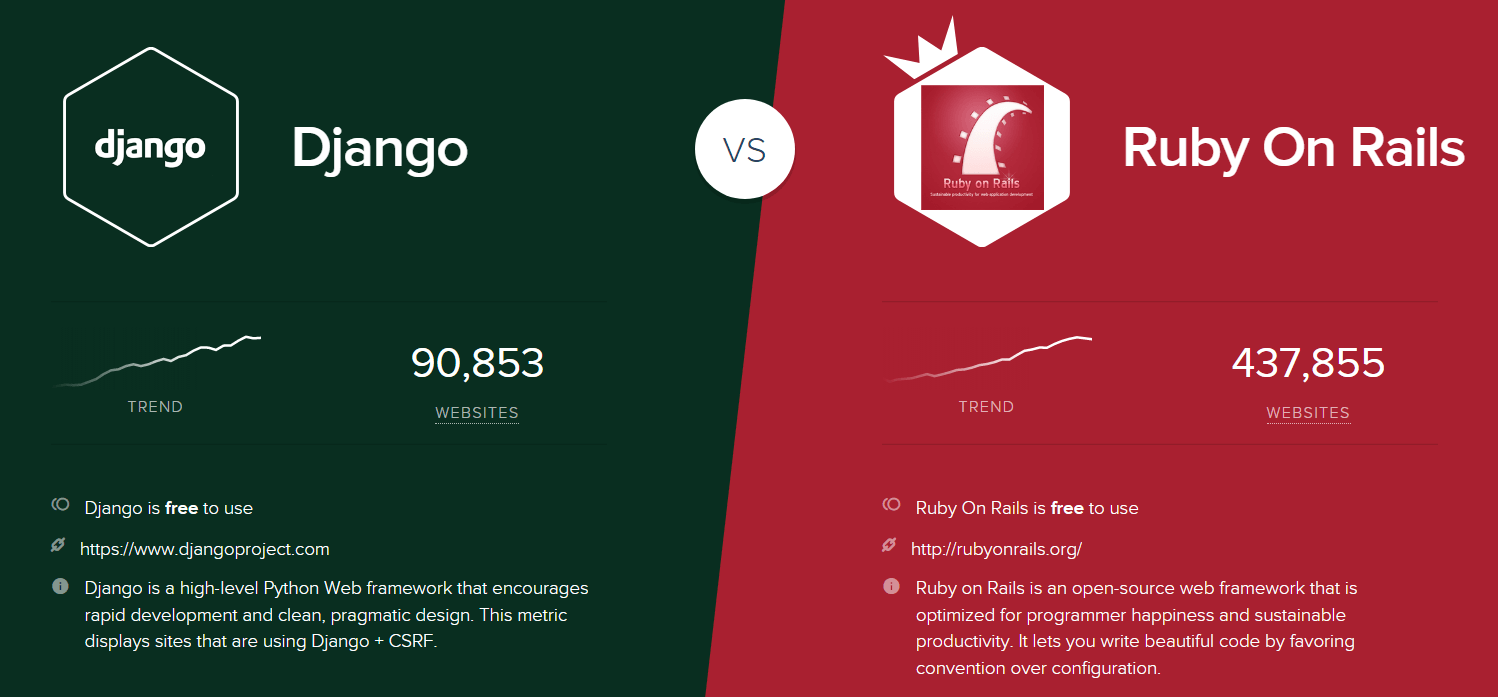
Also according to the below graph by SimilarTech stats, The Website Usage Ruby on Rails exceeds Django in all industries categorization.

But when we look into google trends, Django Exceeds in terms of popularity. These stats show the popularity of both web development frameworks, even though both frameworks have been around for a long time.

However, according to the stack overflow developer survey 2021, Django is in the top 10 frameworks, quite the opposite of Ruby rails.
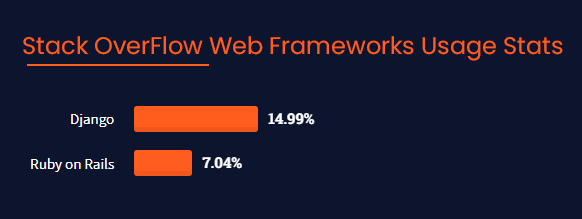
Before digging into the differences between Django vs Rails, let’s first understand each of them respectively.
What is Django?
Django is a Python-based web framework first released in 2005 and is a popular choice for Python app development. Its popularity stems from the fact that it is a multi-purpose, open-source, and free framework. Programmers acclaim Django’s features. It was created to make the process of building complex, database-driven websites easier. With a clean and practical design, this framework facilitates speedy development for professional Python developers.
What is Ruby on Rails?
Ruby on Rails is a server-side, open-source web app framework written under the MIT License. Rails provide fantastic default structures for a database, web services, and pages because it is a model-view-controller framework. It’s thought to be a time-saving approach for Skilled Ruby on Rails Programmers to write code.
The DRY (Don’t Repeat Yourself) and Convention Over Configuration concepts are the foundations of this system. The former avoids the need to repeat the same coding task. Still, the latter indicates that the environment you work in, such as systems, libraries, languages, and so on, provides for a wide range of logical scenarios by default. As a result, rather than building your own, you can adapt to them.
Ruby vs Django: Features
Let’s take a look at the features of both frameworks, respectively.
Ruby on Rails Features
- Action Mailbox
- Action Text
- Multiple Database Support
- Parallel Testing
- Webpack as default bundler
- Zeitwerk, the new code loader
- Optimizer Hints
- Truncate Database
- Security
- Preventing Race Conditions
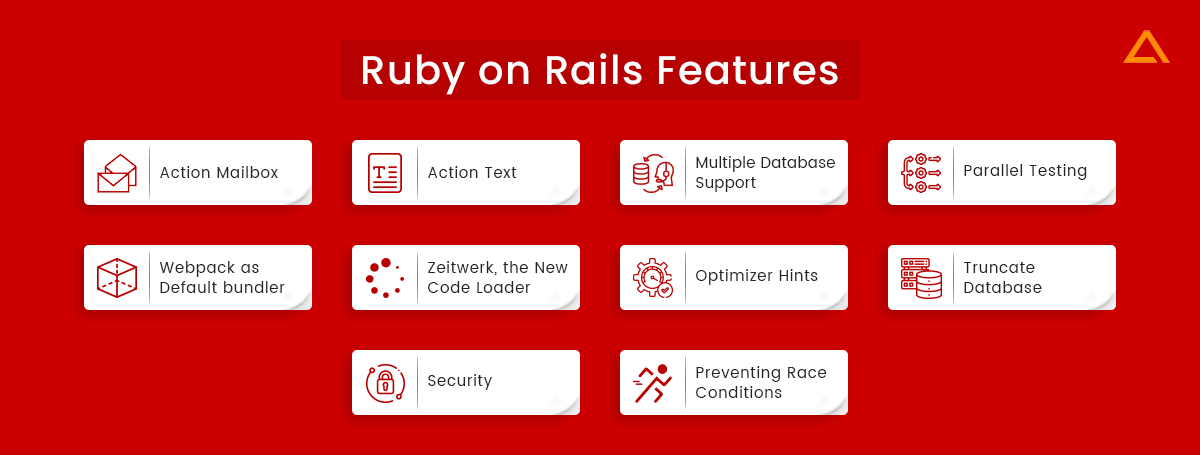
Django Features
- Rapid Development
- Secure
- Scalable
- Fully loaded
- Versatile
- Open Source
- Vast and Supported Community
- SEO Optimized
- Python Wen-Framework
- Versatile in Nature

RoR vs Django: Pros & Cons
Let’s take a look at the Pros and Cons of ROR Vs Django web Frameworks.
Ruby on Rails
| Pros | Cons |
| Easy to modify and migrate | Varying quality and standard of documentation |
| Superior testing environment | Low runtime speed |
| Active RoR community | Tricky to create API |
| High-speed development | Lack of flexibility |
| Diverse tools and presets | – |
Django
| Pros | Cons |
| Highly Scalable | Lacks the capability to handle multiple requests simultaneously |
| Django has the Representational State Transfer (REST) framework | Highly reliable on ORM system |
| Mature Software with numerous Plugins | Makes web app components tightly-coupled |
| Highly Customizable | Too Monolithic |
| Effective Admin Panel | Steep learning curve |
| High compatibility with databases and operating systems | Components get deployed together |
| Adopts Battery-included approach | – |
| Supports MVC | Not for smaller projects |
Ruby on Rails vs Django: Key Differences
Till now, we have seen the features and pros – cons of rails vs Django frameworks. Now let’s take a look at the key differences between Django and Ruby on Rails.
Django vs rails: Language
Rails are written in Ruby, whereas Django is written in Python. Python is a popular programming language that emphasizes code clarity and readability, whereas Ruby is known for its flexibility and freedom and its simple syntax.
On the other hand, Ruby was built with the intention of “enjoying” the programming process. The major difference lies beneath the surface, even if the applications produced with either of them appear and behave virtually identically.
Django vs rails: Architecture
The use of MVC is something that both web development frameworks have in common (Model-View-Controller). In Django, however, it is referred to as MVT (Model-View-Template). MVC and MVT are similar in most ways, with a few exceptions.
In Django, the Model is the database that describes the data structure, while the View is the Regular Expression-based URL Dispatcher that defines what the users should see. Last but not least, a web templating system based on the Django Template Language is referred to as Template (DLT). In this situation, Django takes care of the ControllerController.

The Model in RoR refers to the database’s data, including comments, images, and posts. Everything is taken care of by ActiveRecord. The View covers the data in the HTML template before passing it to the ControllerController, which ActiveView then handles. The ActionController now connects the Model and View and processes requests and returning responses to the web browser.

Django vs rails: User Interface
Both Django and Rails come out on top when it comes to the user interface. It’s because they’re both designed to deliver a premium experience. Web App Development Companies can use these web-centric frameworks to create completely functional websites with the right add-ons and plugins.
Django vs rails: Performance & Speed
In a comparison between Django vs Rails performance, Rails is 0.7 per cent quicker. It’s because Rails has access to a large library of fantastic modules and plugins that help to improve the framework’s speed and, as a result, its performance. Django, on the other hand, promotes rapid development and is a fantastic web framework alternative.
Authentication modules, JSON serializers/deserializers, and other features of the Django REST framework add convenience. When comparing the development frameworks Django vs RoR, we can claim that Django has a slight advantage because REST is one of Django’s key features.
Nonetheless, Django vs Rails has good performance because they use modern programming languages and provide tools to optimize the code.
Ruby Rails vs Django: Stability
Innovation and stability are two complementary factors in the creation process. The winner who can effectively do both could be chosen. Because Ruby on Rails allows users to reuse code and eliminate dependencies, it can handle both. It also employs configuration convention procedures, which relieve coders of additional work.
On the other hand, Python takes a more traditional approach to solving problems by keeping to any proven method. This provides stability.
Django vs rails: Installation
It’s not difficult to compare Django to Ruby on Rails, depending on the installation method. Django’s installation process is relatively straightforward, and it takes only a few minutes to complete.
However, the same cannot be stated with RoR. You must first learn about bundles and gems, as they are essential to install Ruby’s packages. These two are downloaded, and then the command gem install rails are used to install the latest version of the Rails framework.
Django vs Rails: Security
We had to include the security component in our comparison of Django vs Rails because it is an important part of any website or application.
Django has unquestionably defeated Python in this area. Yes, NASA uses Django frameworks, which is proof enough of its stability. Django relies on middleware, whereas Rails relies on active files. Django includes capabilities to defend your Django app from SQL injection, cross-site scripting, and other security threats.
Overall, both web development frameworks are solid choices that can be relied upon for security.
Django vs Rails: Scalability
While the Django web framework has inherited Python’s scalability, it still trails behind Rails. Because of its qualities like freedom and code flexibility, it has superior scalability. Both are heavyweight web development frameworks, and both are developed with scalability in mind, but Ruby on Rails development takes the win.
Django vs Rails: Syntax
Ruby’s grammar is well-known for being extremely adaptable. The benefits of Ruby on Rails, on the other hand, cannot always be linked to this. It can cause issues and make it more difficult to pass the task on to other team members because one feature might be implemented in various methods, leading to confusion.
On the other hand, Python believes that there should only be one straightforward way to do things, which makes debugging and reading code easier.
Django vs Rails: Development Principle
The glue that keeps the web app development process together is principles. Django features two significant principles: DRY (which we learned earlier) and “Explicit is better than Implicit.” This concept aids programmers in creating user-friendly Software that a large group of people can administer.
Design principles abound in Ruby on Rails. It also employs DRY and Convention on Configuration, implying that you must adhere to established norms rather than creating your configurations. This boosts efficiency and speed.
Django vs Rails: Framework Documentation
To be clear, there is a connection between the design frameworks of Django and Rails in this regard. Because all frameworks are well-known, the most common FAQs and answers to questions are readily available. Both have very straightforward, intelligible, and transparent documentation without putting the reader in a condition of confusion.
Django vs Rails: Development Maturity of platform
Django was first launched in 2005 and has since ranked among the greatest web development frameworks. In April of this year, he published a new version with numerous additional features and enhanced usability. Ruby on Rails was first launched in 2003 and became an open-source program in 2004. It is also routinely updated since the most recent version was released in August 2018.
Django vs Rails: Development HTML Templating
Although templates are an essential element of Django and Ruby on Rails, Django employs a simple template language to allow developers to construct templates with basic programming and HTML skills. Rails, on the other hand, has a more complex perspective (individual page templates).
Django vs Rails: Usage
Django is the way to go if you’re searching for a framework that can help you construct complex database-driven websites and web apps in less time while also providing system management, scientific programming, data analytics, and manipulation performance.
On the other hand, Ruby aids the development of database-backed web projects by giving Ruby on Rails Developers more flexibility and control. Ruby’s architectural flexibility makes it an excellent choice for meta programming and creating entertaining scripts.

You can find more ideas of their usage with the Stack Overflow Trends.
Django vs Rails: Web Server
The main web servers for Django are NGINX with WSGI, Apache, Gunicorn, and Cherokee. SQLite, PostgreSQL, MySQL, and Oracle are the database servers used by Django.
NGINX, Apache (with the Phusion Passenger Module), and WEBrick are the main servers used by the Ruby on Rails web framework. PostgreSQL and MySQL are two database servers for Rails.
Django vs Rails: Community Support
Because Django is an open-source framework, it also has an open-source ecosystem, which means that Python developers have access to many libraries and tools, both paid and free. Furthermore, if you require a solution to an issue, the standard Django documentation is more than adequate.
Over 11,000 people contribute to the Django community, which includes over 4,000 ready-to-use packages for developers. On the other hand, Ruby on Rails has a loyal community of 5,000 people who have already contributed a large number of Gems with reusable code.
Ruby On Rails Vs Django: Learning Curve
Ruby on Rails is one of the most difficult learning curves due to a slew of separate ideas that must be grasped before you can even begin comprehending the Rails environment.
People generally agree that Django is the easier of the two options. Django has a highly easy learning curve because Python is a very simple programming language to understand, and Django is so rigid.
Ruby On Rails Vs Django: Salary
According to GlassDoor Salaries,
The Average Base Salary Per Anum(USD) for Ruby on rails is $1L/ year.

The Average Base Salary Per Anum(USD) for Django is $91k/ year.

Tabular Comparision of Ruby On Rails Vs Django
| Factors | Ruby on Rails | Django |
| Original Authors | David Heinemeier Hansson | Adrian Holovaty, Simon Willison |
| Initial Release | August 2004 | 21 July 2005 |
| Stable release | 6.1.4 | 3.2.7 |
| Written in | Ruby | Python |
| Type | Web application framework | Web Framework |
| License | MIT License | BSD License |
| Purpose | Web applications | Web applications, Desktop applications, ML Solutions |
| Operating System | Cross-Platform | Cross-Platform |
| Memory recommended | 1GB | 128MB |
| Startup Time | 1s | 2s |
| Difficult Time | Advanced | Medium |
| Philosophy | Convention over Configuration” “Progress over stability” “Don’t Repeat Yourself.” | “Explicit is better than implicit”, “Don’t Repeat Yourself”, “Loose coupling, tight cohesion.” |
| Flexibility | Rails provide flexibility to developers to be innovative. | Django is very opinionated. Offers very little flexibility compared to Rails |
| Community Support | Rails have a small community of dedicated developers | Django is much more popular and has a very active community |
Django vs Rails: Popular Applications
Following is the list of the popular companies using Ruby-on-Rails and Django.
Ruby On Rails Or Django: Which One To Choose?
When To Use Ruby on Rails?
Let’s look at when Ruby on Rails should be used now that we’ve learned the differences between the two backend frameworks.
In the following situations, the Rails web framework is suggested for web projects:
- Meeting Short Deadlines.
- Real-Time Updates & Scalability.
- MVP Development.
- For Startups and small businesses that require high scalability and performance.
- eCommerce Project.
- Quick Prototyping.
- While working with popular front-end frameworks and libraries.
- Complex Project with unique features & Functionalities.
When to Use Django?
Django is one of the most popular Web App Frameworks for developing Python applications. However, when comparing the frameworks, it’s crucial to consider your needs before deciding on one.
When developing, we recommend using the Django framework.
- Django includes a fantastic ORM for working with huge databases, ideal for complex database-driven websites.
- Data-visualization and analysis projects
- Projects requiring math
- Heavy user traffic web apps
- Rest APIs
- Highly secure web apps that project against common vulnerabilities
- Large Projects with multiple team members
- ML/AI Features.
have a unique app Idea?
Hire Certified Developers To Build Robust Feature, Rich App And Websites
Django Vs Ruby On Rails: Which One is Right For Your Requirments?
Although both are backend frameworks, Ruby on Rails vs Django is appropriate for various web projects. For early-stage startups and small businesses, Ruby on Rails is a better alternative than Django. Ruby on Rails is the appropriate choice if your project calls for a simple web application. On the other hand, Django is better suited to large businesses that need to manage several databases and a more uniform, large-scale web application.
However, when it comes to eCommerce applications, Django vs ruby on rails are two prominent web frameworks that offer outstanding security. The performance of Rails and the community support provided by Django will assist you in choosing between these two popular web development frameworks.
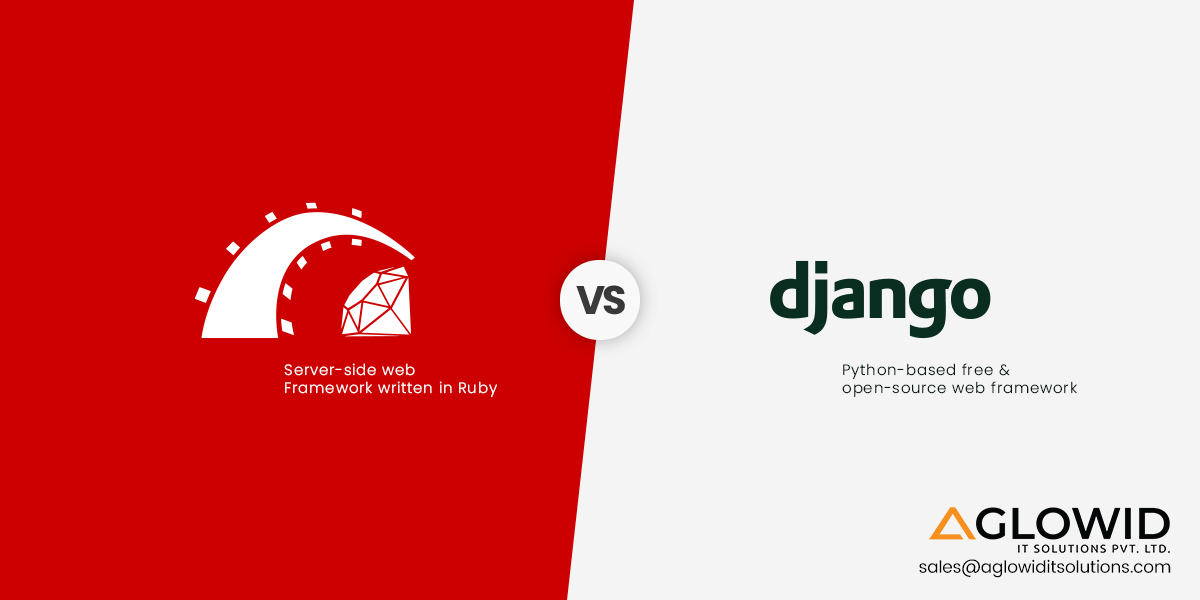
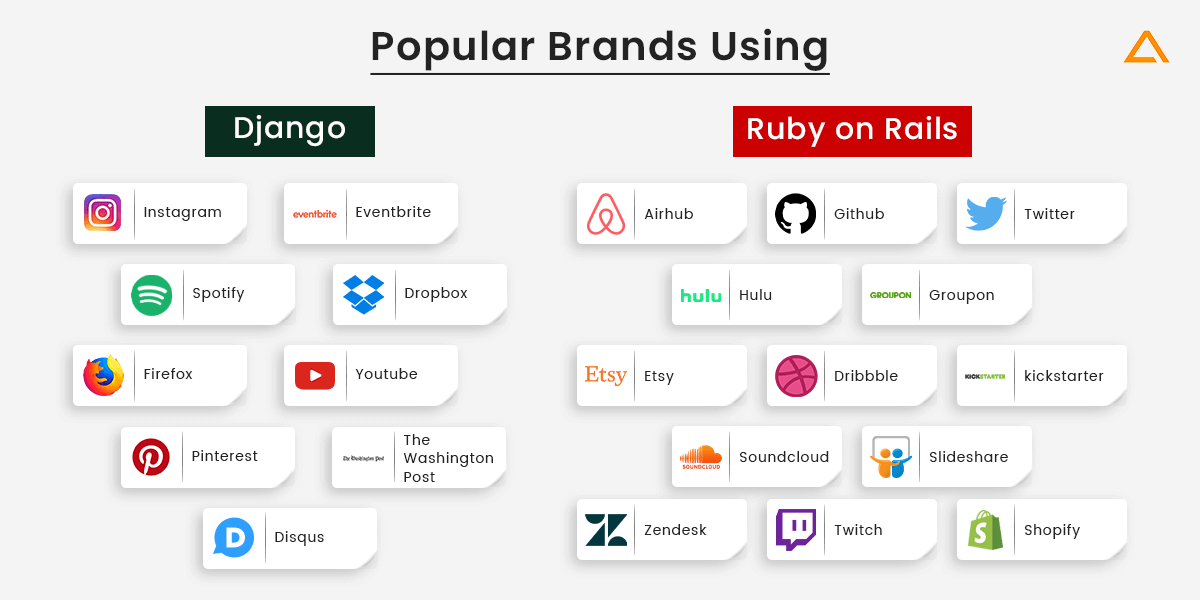




 Say
Say